Feasibility Study of Steel Derailment Containment Provisions through Quasi-Static Experiments
Abstract
1. Introduction
Significance and Scope of the Study
2. Experimental Program
2.1. Steel DCP System Details
2.2. Single Anchor Testing
2.3. Steel DCP System Testing
3. Results and Discussion
3.1. Load–Displacement of Single Anchor
3.2. Load–Displacement of Steel DCP System
3.3. Initial Stiffness Analysis
4. Conclusions
Author Contributions
Funding
Data Availability Statement
Conflicts of Interest
References
- Kim, H.; Sultana, S.; Weber, J. A geographic assessment of the economic development impact of Korean high-speed rail stations. Transp. Policy 2018, 66, 127–137. [Google Scholar]
- Jia, S.; Zhou, C.; Qin, C. No difference in effect of high-speed rail on regional economic growth based on match effect perspective? Transp. Res. Part A Policy Pract. 2017, 106, 144–157. [Google Scholar] [CrossRef]
- Verma, A.; Sudhira, H.S.; Rathi, S.; King, R.; Dash, N. Sustainable urbanization using high speed rail (HSR) in Karnataka, India. Res. Transp. Econ. 2013, 38, 67–77. [Google Scholar]
- Yang, X.; Lin, S.; Zhang, J.; He, M. Does High-Speed Rail Promote Enterprises Productivity? Evidence from China. J. Adv. Transp. 2019, 2019, 1279489. [Google Scholar]
- Yanhui, L.; Al-Bukhaiti, K.; Shichun, Z.; Abas, H.; Nan, X.; Lang, Y.; Yu, Y.X.; Daguang, H. Numerical study on existing RC circular section members under unequal impact collision. Sci. Rep. 2022, 12, 14793. [Google Scholar] [PubMed]
- Montenegro, P.A.; Carvalho, H.; Ribeiro, D.; Calçada, R.; Tokunaga, M.; Tanabe, M.; Zhai, W.M. Assessment of train running safety on bridges: A literature review. Eng. Struct. 2021, 241, 112425. [Google Scholar]
- Cao, Y.; An, Y.; Su, S.; Xie, G.; Sun, Y. A statistical study of railway safety in China and Japan 1990–2020. Accid. Anal. Prev. 2022, 175, 106764. [Google Scholar]
- Evans, A.W. Fatal train accidents on Europe’s railways: An update to 2019. Accid. Anal. Prev. 2021, 158, 106182. [Google Scholar]
- Liu, X.; Rapik Saat, M.; Barkan, C.P.L. Freight-train derailment rates for railroad safety and risk analysis. Accid. Anal. Prev. 2017, 98, 1–9. [Google Scholar]
- European Union Agency for Railways. Report on Railway Safety and Interoperability in the EU; Publications Office of the European Union: Luxembourg, 2022.
- Zhang, Z.; Turla, T.; Liu, X. Analysis of human-factor-caused freight train accidents in the United States. J. Transp. Saf. Secur. 2021, 13, 1157–1186. [Google Scholar]
- Dindar, S.; Kaewunruen, S.; An, M. A hierarchical Bayesian-based model for hazard analysis of climate effect on failures of railway turnout components. Reliab. Eng. Syst. Saf. 2022, 218, 108130. [Google Scholar] [CrossRef]
- Wu, X.; Chi, M.; Gao, H.; Ke, X.; Zeng, J.; Wu, P.; Zhu, M. Post-derailment dynamic behavior of railway vehicles travelling on a railway bridge during an earthquake. Proc. Inst. Mech. Eng. Part F J. Rail Rapid Transit. 2014, 230, 418–439. [Google Scholar] [CrossRef]
- Heleno, R.; Montenegro, P.A.; Carvalho, H.; Ribeiro, D.; Calcada, R.; Baker, C.J. Influence of the railway vehicle properties in the running safety against crosswinds. J. Wind Eng. Ind. Aerodyn. 2021, 217, 104732. [Google Scholar] [CrossRef]
- Brabie, D.; Andersson, E. Dynamic simulation of derailments and its consequences. Veh. Syst. Dyn. 2006, 44 (Suppl. S1), 652–662. [Google Scholar] [CrossRef]
- Brabie, D. Wheel-Sleeper Impact Model in Rail Vehicles Analysis. J. Syst. Des. Dyn. 2007, 1, 468–480. [Google Scholar] [CrossRef]
- Brabie, D.; Andersson, E. Post-derailment dynamic simulation of rail vehicles–methodology and applications. Veh. Syst. Dyn. 2008, 46 (Suppl. S1), 289–300. [Google Scholar] [CrossRef]
- Kajitani, Y.; Kato, H.; Asano, K. Development of an L-shaped guide to prevent deviation from rails. JR-EAST Tech. Rev. 2010, 15, 53–56. [Google Scholar]
- Sunami, H.; Morimura, T.; Terumichi, Y.; Adachi, M. Model for analysis of bogie frame motion under derailment conditions based on full-scale running tests. Multibody Syst. Dyn. 2012, 27, 321–349. [Google Scholar] [CrossRef]
- Guo, L.; Wang, K.; Lin, J.; Zhang, B.; Chen, Z.; Song, X.; Du, G. Study of the post-derailment safety measures on low-speed derailment tests. Veh. Syst. Dyn. 2016, 54, 943–962. [Google Scholar] [CrossRef]
- Wu, X.; Chi, M.; Gao, H.; Zhang, D.; Zeng, J.; Wu, P.; Zhu, M. The study of post-derailment measures to limit the extent of a derailment. Proc. Inst. Mech. Eng. Part F J. Rail Rapid Transit. 2014, 230, 64–76. [Google Scholar] [CrossRef]
- Wu, X.; Chi, M.; Gao, H. The study of post-derailment dynamic behavior of railway vehicle based on running tests. Eng. Fail. Anal. 2014, 44, 382–399. [Google Scholar] [CrossRef]
- Tang, Z.; Hu, Y.; Wang, S.; Ling, L.; Zhang, J.; Wang, K. Train post-derailment behaviours and containment methods: A review. Railw. Eng. Sci. 2023. [Google Scholar] [CrossRef]
- Zhang, D.; Peng, Y.; Xu, Y.; Du, C.; Zhang, Y.; Wang, N.; Chong, Y.; Wang, H.; Wu, D.; Liu, J.; et al. A high-speed railway network dataset from train operation records and weather data. Sci. Data 2022, 9, 244. [Google Scholar] [CrossRef] [PubMed]
- Büchel, B.; Spanninger, T.; Corman, F. Empirical dynamics of railway delay propagation identified during the large-scale Rastatt disruption. Sci. Rep. 2020, 10, 18584. [Google Scholar] [CrossRef] [PubMed]
- Cheng, Y.-s.; Loo, B.P.Y.; Vickerman, R. High-speed rail networks, economic integration and regional specialisation in China and Europe. Travel Behav. Soc. 2015, 2, 1–14. [Google Scholar] [CrossRef]
- Guo, B.; Ke, J. The Impacts of High-speed Rail on Sustainable Economic Development: Evidence from the Central Part of China. Sustainability 2020, 12, 2410. [Google Scholar] [CrossRef]
- Bae, H.-U.; Yun, K.-M.; Moon, J.; Lim, N.-H. Impact Force Evaluation of the Derailment Containment Wall for High-Speed Train through a Collision Simulation. Adv. Civ. Eng. 2018, 2018, 2626905. [Google Scholar] [CrossRef]
- Hamilton, B.A. Report on the Findings of: Current Practice and Effectiveness of Derailment Containment Provisions on High Speed Lines; HSL-Zuid Organisation: Zoetermeer, The Netherlands, 2004. [Google Scholar]
- Lai, J.; Xu, J.; Wang, P.; Chen, J.; Fang, J.; Ma, D.; Chen, R. Numerical investigation on the dynamic behaviour of derailed railway vehicles protected by guard rail. Veh. Syst. Dyn. 2021, 59, 1803–1824. [Google Scholar] [CrossRef]
- Mao, J.h.; Xiang, J.; Gong, K. Mechanism and Application of a New Guard Rail for Improving the Stability of Small Radius Curve Tracks with Continuous Welded Rails. In Proceedings of the 2013 Fourth International Conference on Digital Manufacturing & Automation, Qindao, China, 29–30 June 2013; pp. 773–779. [Google Scholar]
- Nishimura, K.; Terumichi, Y.; Morimura, T.; Adachi, M.; Morishita, Y.; Miwa, M. Using Full Scale Experiments to Verify a Simulation Used to Analyze the Safety of Rail Vehicles During Large Earthquakes. J. Comput. Nonlinear Dyn. 2015, 10, 031013. [Google Scholar] [CrossRef]
- Authority, K.R.N. Railway Design Guideline and Handbook—Subsidiary and Safety Facilities for Main Lined; KR C-02060; Korea Rail Network Authority: Daejeon, Republic of Korea, 2017. [Google Scholar]
- Lim, N.-H.; Kim, K.-J.; Bae, H.-U.; Kim, S. DEM Analysis of Track Ballast for Track Ballast–Wheel Interaction Simulation. Appl. Sci. 2020, 10, 2717. [Google Scholar] [CrossRef]
- Song, I.-H.; Koo, J.-S.; Shim, J.-S.; Bae, H.-U.; Lim, N.-H. Theoretical Prediction of Impact Force Acting on Derailment Containment Provisions (DCPs). Appl. Sci. 2023, 13, 3899. [Google Scholar] [CrossRef]
- Bae, H.-U.; Moon, J.; Lim, S.-J.; Park, J.-C.; Lim, N.-H. Full-Scale Train Derailment Testing and Analysis of Post-Derailment Behavior of Casting Bogie. Appl. Sci. 2020, 10, 59. [Google Scholar] [CrossRef]
- Bae, H.-U.; Kim, K.-J.; Park, S.-Y.; Han, J.-J.; Park, J.-C.; Lim, N.-H. Functionality Analysis of Derailment Containment Provisions through Full-Scale Testing-I: Collision Load and Change in the Center of Gravity. Appl. Sci. 2022, 12, 11297. [Google Scholar] [CrossRef]
- Pham, T.M.; Hao, H. Influence of global stiffness and equivalent model on prediction of impact response of RC beams. Int. J. Impact Eng. 2018, 113, 88–97. [Google Scholar] [CrossRef]
- Fujikake, K.; Li, B.; Soeun, S. Impact Response of Reinforced Concrete Beam and Its Analytical Evaluation. J. Struct. Eng. 2009, 135, 938–950. [Google Scholar] [CrossRef]
- Chungnam-National-University; Korea-Railroad-Research-Institute; CS-Global; UBI-E&C; Korea-Railroad-Authority-&-Road-Kinematics. Facility Development and Performance Standard Research for Rail Vehicle Deviation Protection; Chungnam National University: Daejeon, Republic of Korea, 2020. [Google Scholar]
- Tena-Colunga, A. Aspects to Consider in the Assessment of Effective Stiffness for Reinforced Concrete Beams. J. Arch. Eng. 2021, 27, 04020048. [Google Scholar] [CrossRef]
- Ding, F.; Ding, H.; He, C.; Wang, L.; Lyu, F. Method for flexural stiffness of steel-concrete composite beams based on stiffness combination coefficients. Comput. Concr. 2022, 29, 127–144. [Google Scholar]
- Duy, N.P.; Hiep, D.V.; Anh, V.N. Performance of concrete beams reinforced with various ratios of hybrid GFRP/steel bars. Civ. Eng. J. 2020, 6, 1652–1669. [Google Scholar]
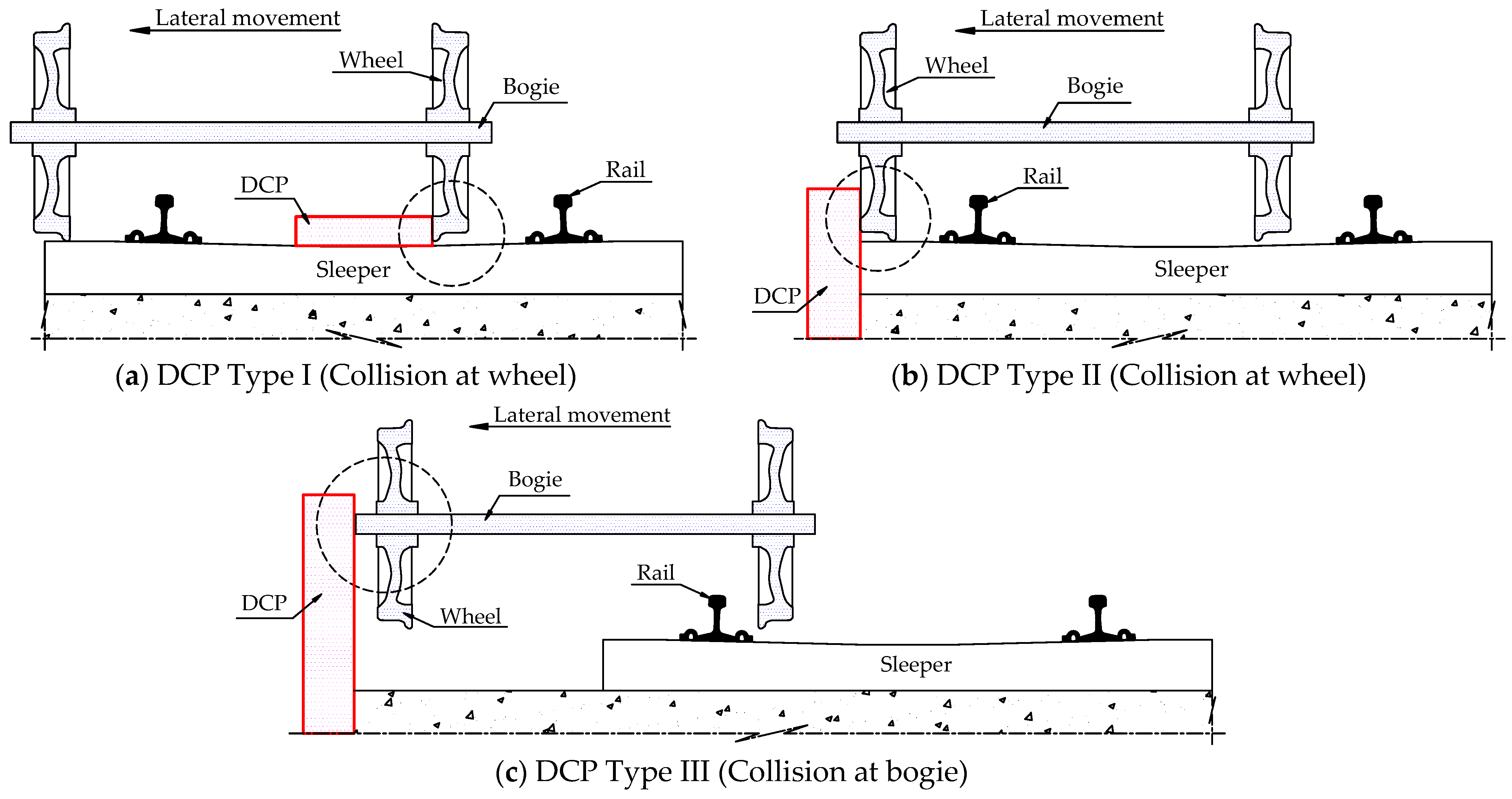

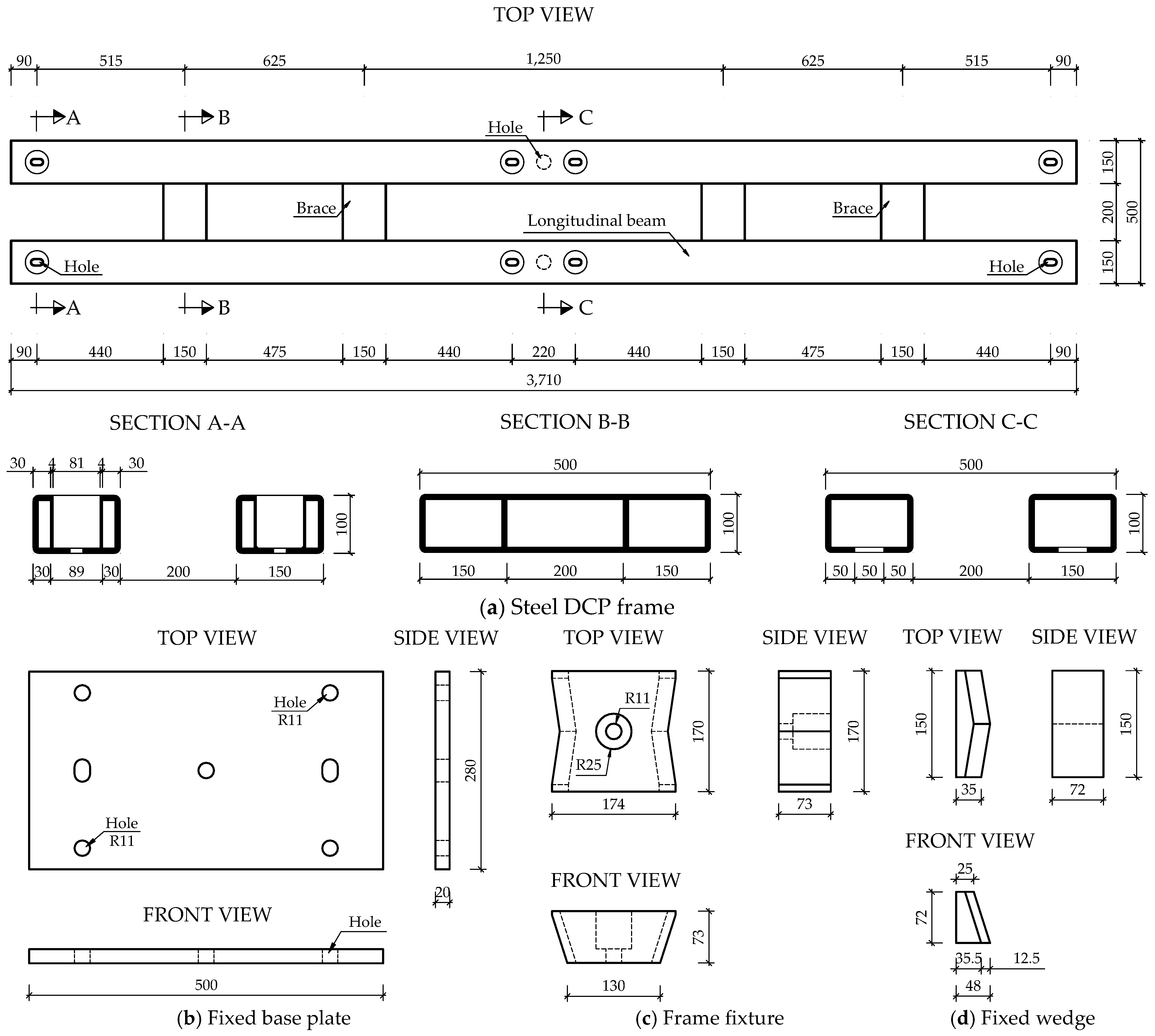
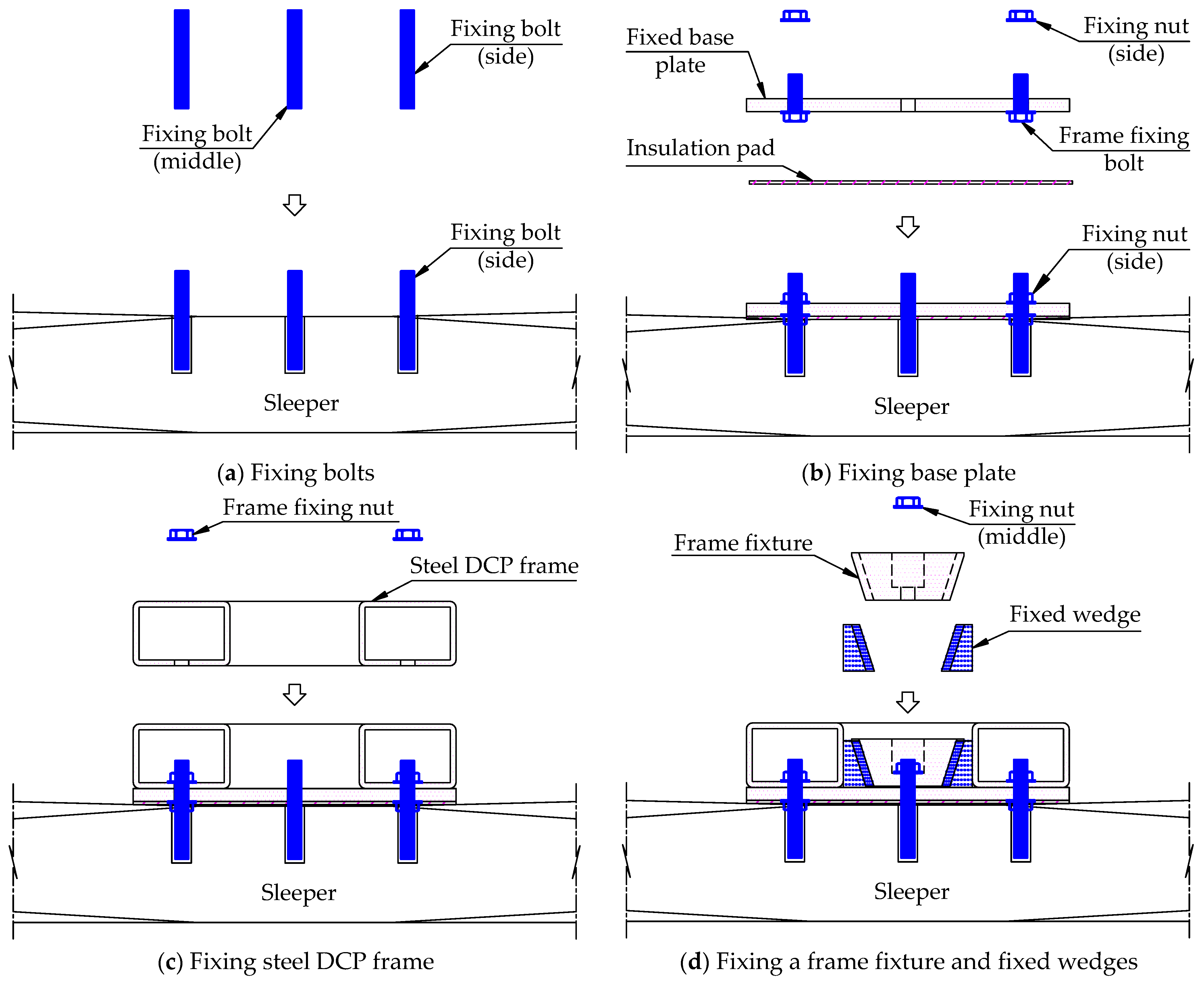

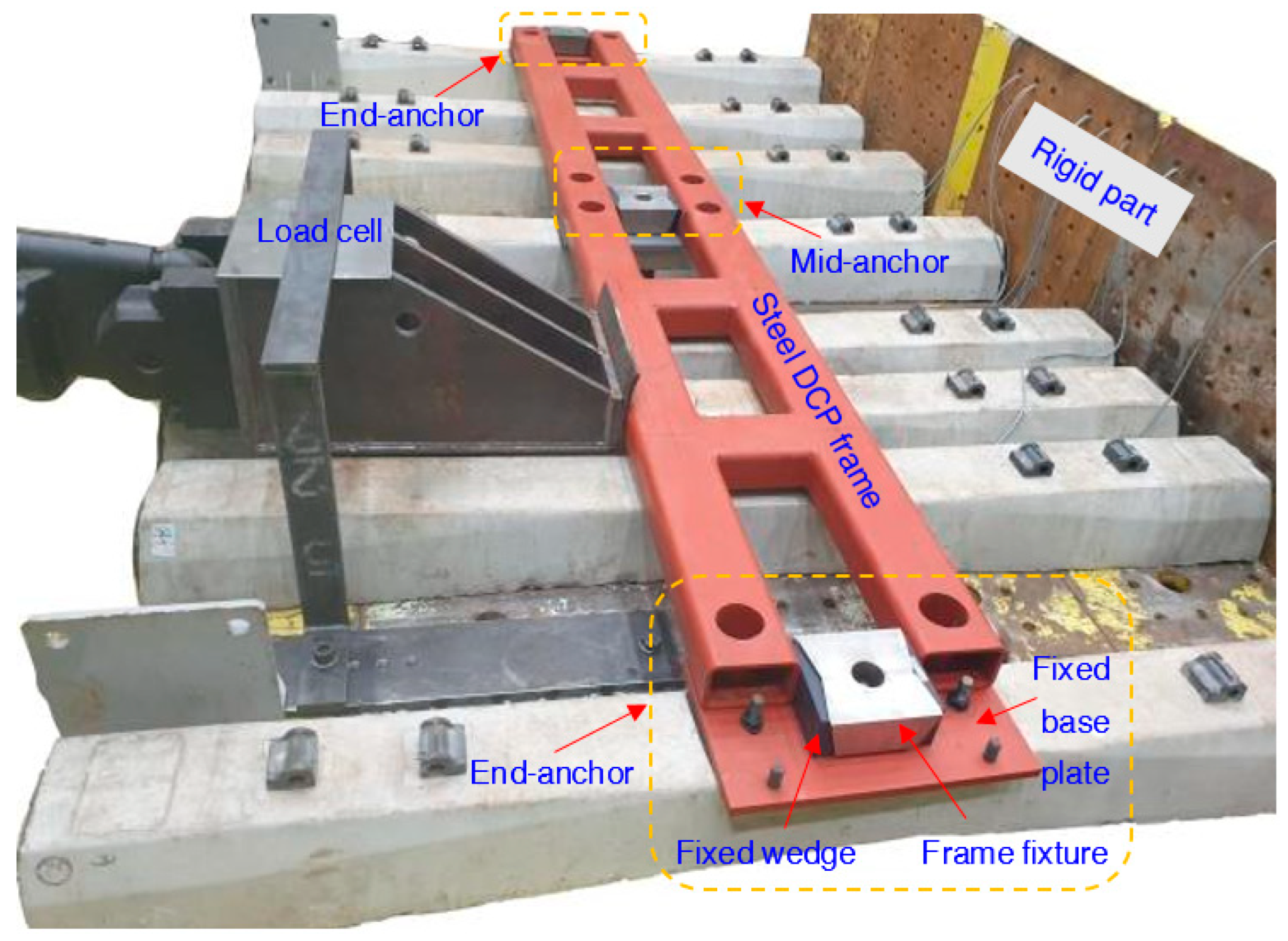
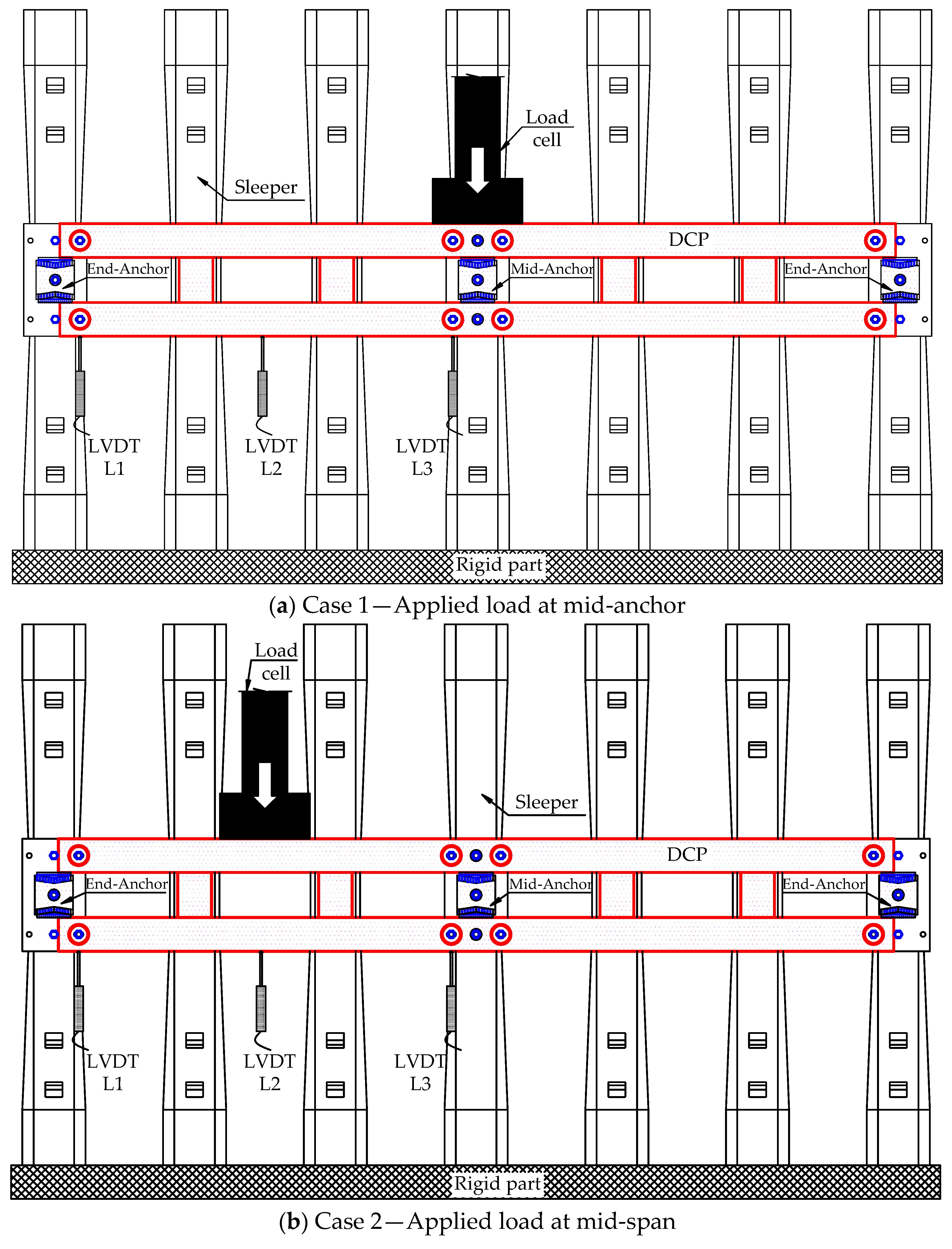
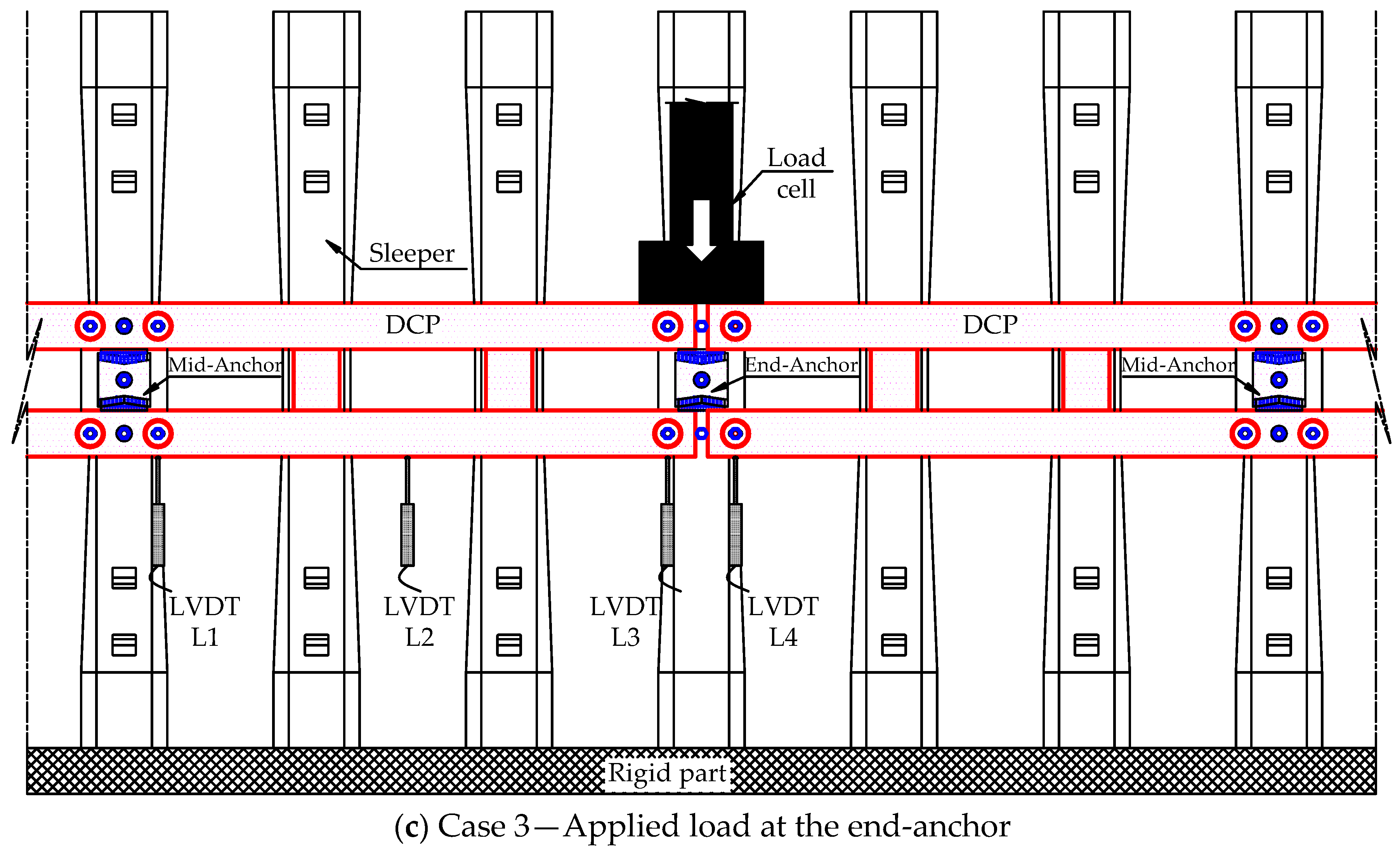
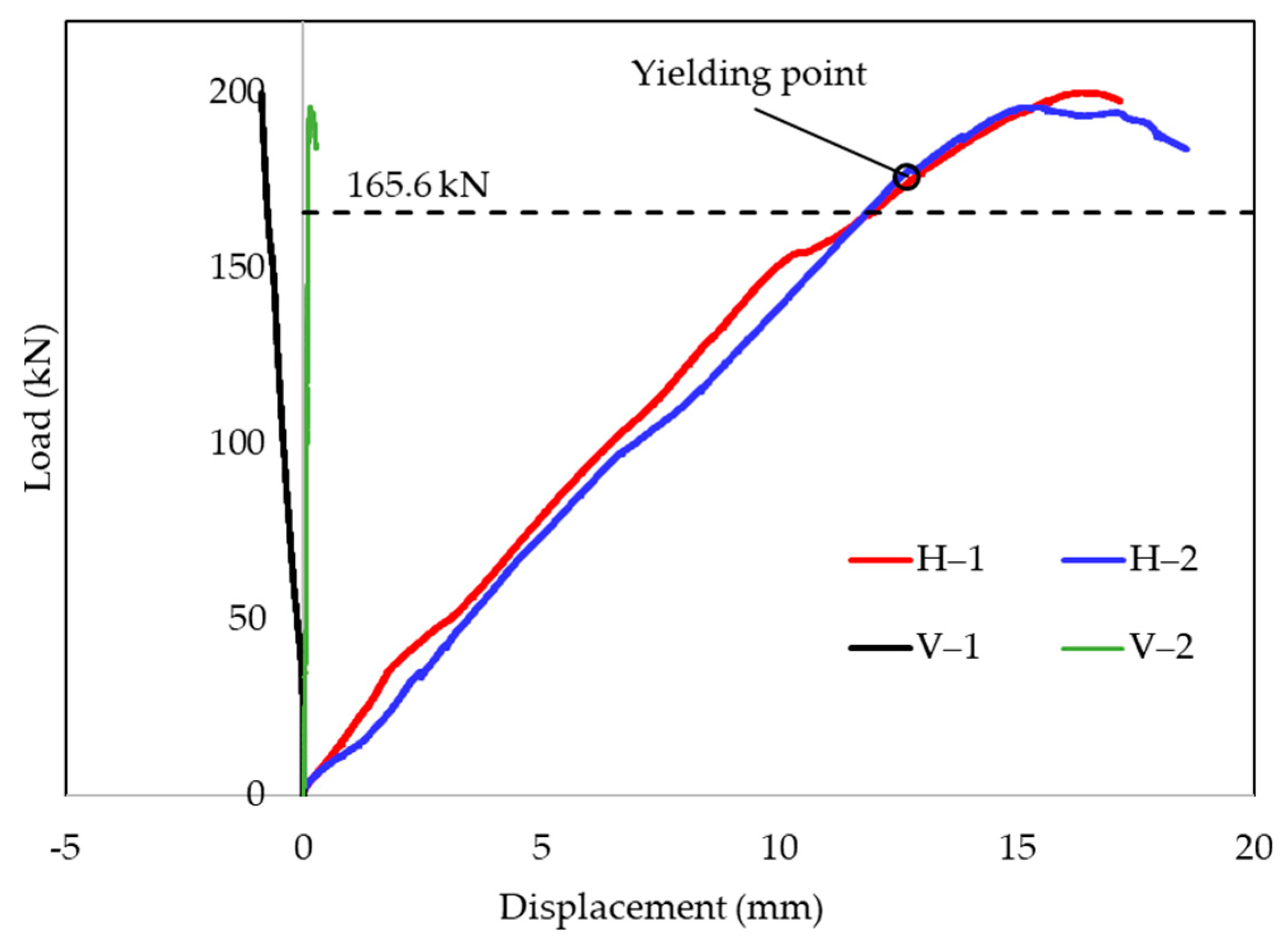

| Specimen ID. | Pu (kN) | Py (kN) | ΔuH (mm) | ΔuV (mm) | ΔyH (mm) | Ki (kN/mm) |
|---|---|---|---|---|---|---|
| S1 | 199.9 | 176.0 | 16.34 | −0.88 | 11.95 | 13.86 |
| S2 | 195.8 | 176.0 | 15.20 | 0.14 | 11.86 | 13.97 |
| Average | 197.9 (2.05) | 176.0 (0) | 15.77 (0.57) | −0.37 (0.51) | 11.90 (0.04) | 13.92 (0.05) |
| Notation | Case 1—Load at Mid-Anchor | Case 2—Load at Mid-Span | Case 3—Load at End-Anchor | ||||||
|---|---|---|---|---|---|---|---|---|---|
| L1 | L2 | L3 | L1 | L2 | L3 | L1 | L2 | Aver. L3&L4 | |
| Designed load (165.6 kN) | 3.32 | 4.20 | 4.58 | 7.16 | 6.32 | 5.41 | 1.28 | 3.34 | 5.95 |
| (0.19) | (0.24) | (0.29) | (0.36) | (0.52) | (0.35) | (0.06) | (0.00) | (0.17) | |
| Target load (207 kN) | 4.35 | 5.35 | 5.84 | 8.93 | 7.83 | 6.98 | 1.74 | 4.64 | 4.35 |
| (0.13) | (0.10) | (0.03) | (0.35) | (0.88) | (0.49) | (0.04) | (0.32) | (0.46) | |
| Initial stiffness (kN/mm) | 35.44 (0.20) | 26.78 (3.00) | 24.62 (1.33) | ||||||
Disclaimer/Publisher’s Note: The statements, opinions and data contained in all publications are solely those of the individual author(s) and contributor(s) and not of MDPI and/or the editor(s). MDPI and/or the editor(s) disclaim responsibility for any injury to people or property resulting from any ideas, methods, instructions or products referred to in the content. |
© 2024 by the authors. Licensee MDPI, Basel, Switzerland. This article is an open access article distributed under the terms and conditions of the Creative Commons Attribution (CC BY) license (https://creativecommons.org/licenses/by/4.0/).
Share and Cite
Nguyen, H.Q.; Kim, H.-J.; Lim, N.-H.; Kang, Y.-S.; Kim, J.J. Feasibility Study of Steel Derailment Containment Provisions through Quasi-Static Experiments. Buildings 2024, 14, 171. https://doi.org/10.3390/buildings14010171
Nguyen HQ, Kim H-J, Lim N-H, Kang Y-S, Kim JJ. Feasibility Study of Steel Derailment Containment Provisions through Quasi-Static Experiments. Buildings. 2024; 14(1):171. https://doi.org/10.3390/buildings14010171
Chicago/Turabian StyleNguyen, Huy Q., Hoe-Jin Kim, Nam-Hyoung Lim, Yun-Suk Kang, and Jung J. Kim. 2024. "Feasibility Study of Steel Derailment Containment Provisions through Quasi-Static Experiments" Buildings 14, no. 1: 171. https://doi.org/10.3390/buildings14010171
APA StyleNguyen, H. Q., Kim, H.-J., Lim, N.-H., Kang, Y.-S., & Kim, J. J. (2024). Feasibility Study of Steel Derailment Containment Provisions through Quasi-Static Experiments. Buildings, 14(1), 171. https://doi.org/10.3390/buildings14010171












